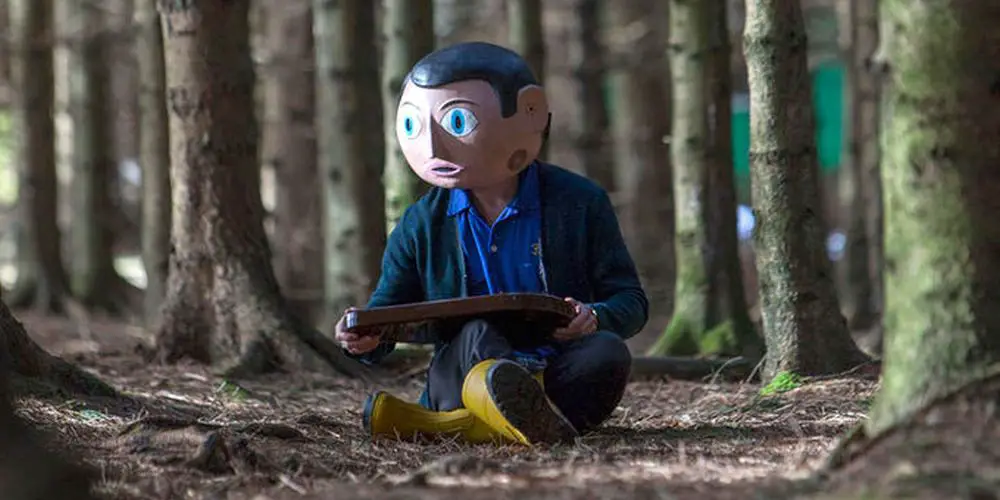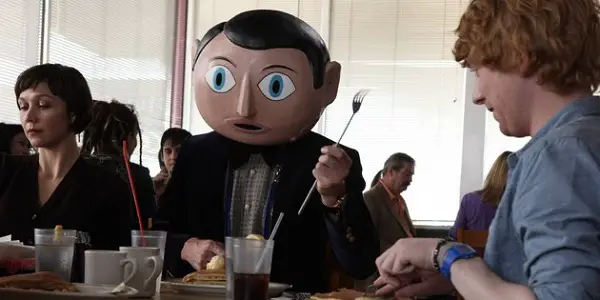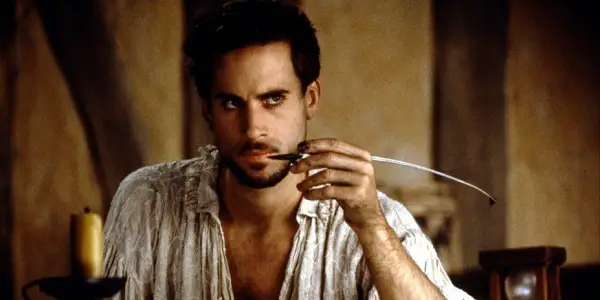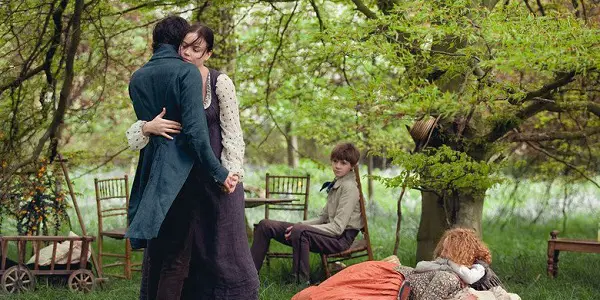Writers On-Screen: The Idealisation Of The Creative Process

Siobhan is a teacher and writer living in Wales, UK.…
Watching Frank recently, it occurred to me how often the creative process is shown on-screen, and how frequently this process is shown in a hackneyed, unsubtle way. Too often directors attempt to over-romanticise the writing process, and feature endless montages of their artists receiving some form of divine inspiration, as if writing was truly that exciting and easy.
Admittedly, showing such a process on-screen is problematic. After all film is a visual medium, and as such, all information should ideally be conveyed in a visual manner. Unfortunately too often this focus on the visual leads to an over-reliance on imagery rather than dialogue or narrative.
The banality of the creative process in Frank
Frank is a wonderful film, featuring a band with an unpronounceable name, whose musical endeavours are hitherto little understood. Jon (Domhnall Gleeson) is an aspiring musician, although we see little evidence of his musical talents beyond his attempts to write witty observational lyrics.
Finding his aspirations thus far are lacking in fruition, he readily accepts an offer to join a band, led by Frank (Michael Fassbender) who wears a giant fake head that he never removes. Lenny Abrahamson’s film perfectly captures the frustration and desperation involved in writing.
When we are first introduced to Jon we are privy to his creative process as he attempts to write a song, singing pedestrian and banal lyrics. While travelling home we hear a fellow bus passenger listening to Madness. Jon, suddenly feeling inspired refuses to allow his parents to talk to him until he has recorded his brilliant song idea, which he rapidly realises, is the Madness song he has just been forced to listen to. This moment of realisation rather wonderfully compounds the frustration of the writing process and the difficulty in creating something truly original and inventive.

This attempt at originality is further demonstrated when Jon, now a member of the band, is compelled to demonstrate his songwriting prowess, a talent that he finds he cannot reproduce on demand. Similarly, we are shown the hours that the band spend attempting to write with little success.
Abrahamson’s decision to show the minutiae of the writing process in all its boredom and dullness is something that is rarely seen on-screen. Ultimately, much to most directors’ chagrin, writing is relatively boring. When writing it is rare to suddenly feel inspired to write something fully formed and perfect. Rather for most writers, the process is a long hard slog.
For anyone who is a writer of some form, they will recognise the ensuing maddening aspect of writing. The idea that this art form, one which you so love and are so desperate to succeed in, is also a form that you at times feel true loathing towards.
The hackneyed approach in Shakespeare in Love
Depicting the canonical writer’s creative process in Shakespeare in Love, but rather than represent the likely reality, director John Madden litters the film with irritating coincidences that apparently lend themselves to Shakespeare’s creations.
Take for example, his process in creating ‘Romeo and Juliet’, the focus of the film’s narrative. Shakespeare is struggling to find inspiration, a feeling that is relatively familiar to most writers. He creates a title for his work, and begins to create a central conceit, but finds it difficult to flesh out the subsequent narrative.
It is fortunate then, that at the moment when he is feeling least inspired he meets Viola de Lesseps, disguised as a man in order to audition as an actor. Lucky too, that Viola is promised to another man, has a witty and bawdy nurse as a companion and is compelled to perform her duty for her family; aspects of which all, rather serendipitously, end up featuring rather heavily in ‘Romeo and Juliet’.

Some moments in the film feel almost laughable in their premise. Certainly writers take ideas from the world in which they inhabit, or ideas from their personal experiences, but the manner in which they fall into place here feel far too easy. Thus, Shakespeare’s rather maudlin decision to turn his pirate comedy into a tragedy, prompted rather suddenly by his realisation that he will not be able to marry Viola, feels entirely unsubtle.
Furthermore, the decision to feature a plethora of inspiration that is often readily lifted verbatim from others undermines the apparent genius of the character. Should we really admire a writer who seemingly copies lines heard on the street? Depicting Shakespeare hearing a Puritan preaching ‘The Rose smells thusly rank, by any name!’ and ‘I say a plague on both their houses’ is, rather than lending itself to demonstrating the creative process, apathetic and lazy.
The organic process in Bright Star
Bright Star adopts an interesting approach in depicting the life of John Keats. Keats (Ben Whishaw) is both a creative genius and a man of flesh and blood. That is, we witness the creative process alongside his interactions with his friends and loved ones. Director Jane Campion makes a conscious decision to portray Keats as a man of both wit and humour. He readily catches butterflies with the young siblings of Fanny Brawne, running through the fields without affectation.
Campion does not hold Keats up to be some sort of untouchable genius, nor does she depict his writing process as legendary. Instead we see Keats struggling to write with his writing associate Charles Brown. It is Brown’s character that attempts to enforce some control over the process, compelling Keats to work on his poetry even when it is clear that he is not ready to do so. Keats readily leaves his writing, recognising that the process is one that is organic and cannot be prompted when inspiration is lacking.

Keats too, rather refreshingly, shows little pretension in the concept of poetry. He willingly begins to teach Fanny how to write poetry, not caring for either gender roles or suitability. For Keats, while poetry should be a source of income, it is also an art form that is necessary and enjoyable.
Take the scene in which Keats is show writing ‘Ode to a Nightingale‘ while Fanny works on her needlework. Showing the two processes simultaneously, Campion makes it clear that she values both pursuits as art forms. For a poet such as Keats the temptation would be, for a lesser director, to feature his writing as almost celestial.
Instead Keats sits in the garden, listening to the nature surrounding him, and calmly and gently writes. There is a sense that his writing here, rather than suddenly happening, is the culmination of many weeks of reflection and contemplation.
A natural and believable creative progress
How then, can a director depict the creative process in a way that is both natural and believable? It is important to avoid mythologising both the process and the art form itself. Too often directors adopt a portent tone in their narrative suggesting that, due to their art, the writer is somehow exceptional and should be treated as such.
Imbuing such a notion is not only isolating for an audience, but does little to truly shed any light on the process itself. Better then, to ensure that these artists are shown to be fully formed functioning human beings rather than some heavenly being.
How do you think the creative process should be shown on-screen?
Does content like this matter to you?
Become a Member and support film journalism. Unlock access to all of Film Inquiry`s great articles. Join a community of like-minded readers who are passionate about cinema - get access to our private members Network, give back to independent filmmakers, and more.
Siobhan is a teacher and writer living in Wales, UK. She holds a BA in English and an MA in Film and Television Studies. She is especially interested in depictions of female desire, transitions from youth to adulthood and performative gender. She tweets at @siobhan_denton and writes at https://theblueandthedim.wordpress.com/













